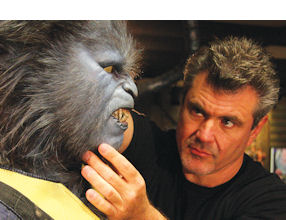Hollywood blockbusters are thriving in an era of computer-generated special effects, when digital images can create the illusion of flying through space on the Starship Enterprise. But Alec Gillis, 53, and Tom Woodruff Jr., 54, two old school San Fernando Valley effects artists, believe there is a still a place for costumes, animatronic suits and other pre-digital techniques. What the pair didn’t realize was that there is a movie fan base that felt the same way. To raise the initial funding for their film “Harbinger Down” – described by Gillis as “The Deadliest Catch” meets “Alien” or “The Thing” – the pair turned to crowdsourcing through Kickstarter. The film drew the interest of more than 3,000 people donating as little as $5 and as much as $10,000 to raise $384,818 through June 7 when the campaign ended. While not enough money to make “Harbinger Down,” the duo expects the Kickstarter funds will attract other, deep-pocketed private investors. “I now have people waiting in the wings to bring more money to the project,” Gillis said. The movie is set on a fishing trawler attacked by microscopic creatures that morph into killing machines, but there are broader issues at play. The partners’ Chatsworth-based effects house, StudioADI, founded in 1988, has worked on films ranging from “The Santa Clause” to Alien 3” to “Cast Away.” They want to show the value of physical, non-CGI effects and their cost effectiveness. For example, they can make animatronics – motion-controlled mechanical figures – at a cost three times to six times less than what it costs to do the same with computer graphics. “We can go quietly or step up and become our own content providers,” Gillis said. Gillis and Woodruff are taking their time in the pre-production for “Harbinger Down.” A final budget has yet to be finalized and the only cast member on board is veteran sci-fi actor Lance Henriksen, who has worked with StudioADI on 10 big-budget films. The plan is to start filming late this year or early next. When production starts, Gillis will take cues he learned early in his career when working for director Roger Corman, the Hollywood legend who knew how to stretch a dollar on his low-budget films. “I will bring those sensibilities back to this kind of filmmaking and make a statement that if you put priorities in the right place you don’t have to have a big, soulless, bloated film,” Gillis said. – Mark R. Madler
